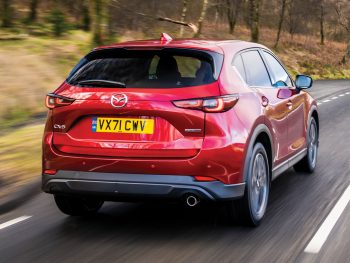Road Test: Mazda CX-5
One of Mazda’s key fleet models gets an overhaul. Olly Benn explains more.

The new CX-5 has a choice of petrol and diesel engines and five trim levels
The CX-5 has been a big success for Mazda since it launched in 2012. A combination of competitive RVs and the burgeoning demand for SUVs meant that demand was not in short supply. Today, CX-5 represents around 25% of the total sales within Mazda UK. With SUVs accounting for 65% of the company’s sales, it is expecting in the region of 9,000 CX-5 sales in 2022.
Mazda recognises the changing world of hybrid and electric models ahead, but also remains committed to ICE customers. There’s no hybrid, instead the Japanese manufacturer has opted to stick with its impressive Skyactiv petrol and diesel offerings. Those looking for a petrol CX-5 will have the choice of a 163hp 2.0-litre (manual and auto) or 191hp 2.5-litre engines. The diesel range covers a 148hp, 2.2-litre unit and a 181hp variant. The latter is offered in 4WD spec, alongside the 2WD models.
The new CX-5 features five trim levels: SE-L; Newground; Sport; Sport Black and GT Sport. The best-seller is expected to be the Sport, which is offered with both diesel and petrol options. Those drivers wishing to stand out a bit more can opt for the GT Sport, with its one-colour exterior and high-quality interior. Inside you will find Nappa leather, woodgrain and other luxurious materials.
All CX-5s feature a 10.25-inch centre display unit, which is linked to the latest version of Mazda Connect infotainment. Alongside that sits a ‘multi-information display’, mounted within the right-hand dial of the instrument binnacle. Featuring a 4.6-inch display it shows key information related to vehicle performance and infotainment. Drivers of Sport, Sport Black and GT Sport models benefit from a larger, 7-inch TFT dial set. Those three ranges also come with a windscreen-mounted display, incorporating traffic sign recognition, navigation and vehicle status details.
The 2022MY CX-5 also sees interior improvements in the seats and steering wheel. In the case of the former, body support and comfort levels have been upgraded, while Sport versions feature an eight-way adjustable power system with two memory presets. Helpfully, they allow for the automatic adjustment of the head-up display. Steering wheels on Sport, Sport Black and GT Sport models get a heated rim, while the switches are laid out in a row for improved functionality.
Another improvement to note is the addition of Mi-Drive, Mazda’s intelligent drive technology, available on petrol automatic models. Using this system, drivers can select the most appropriate drive mode, depending on the road type, conditions and speed limits. Safety-wise and an updated range of Mazda’s i-Activesense safety systems, including Cruise & Traffic Support (CTS). This feature helps reduce driver fatigue by assisting with accelerator, brake pedal and steering operations when stuck in traffic.
IN BRIEF
WHAT IS IT? C-SUV
HOW MUCH? from £22,945
ECONOMY? 35.3-50.4mpg
EMISSIONS? 147-182g/km
Key fleet model: 2.0-litre Sport
Advantages: Interior quality; standard equipment
Disadvantages: No hybrid option; road noise
7-word summary: Upgrade welcomed for a core Mazda product
Also consider: Ford Kuga / Kia Sportage / Škoda Karoq













Bw14. Jul, 2022
My diesel is currently doing 65 mpg on motorway runs and late 50s locally. Its the stand out version (148) and Iove it.
The petrol 2.o is underpowered imho and you have yo realky drivevit. It only achieves about 40mpg. A huge disparity. Despite the cost of diesel YOU REALLY SHOULD TRY the 148 2.2 diesel first. )